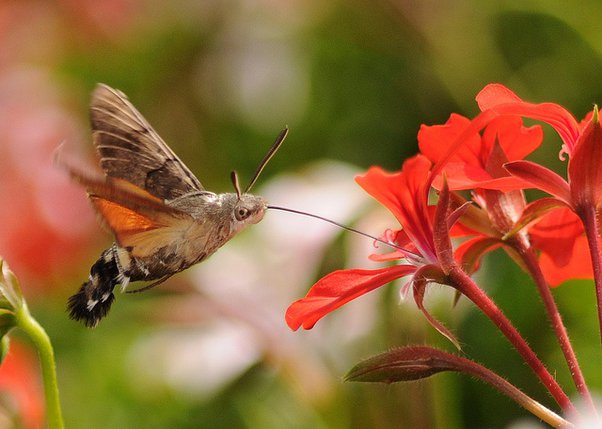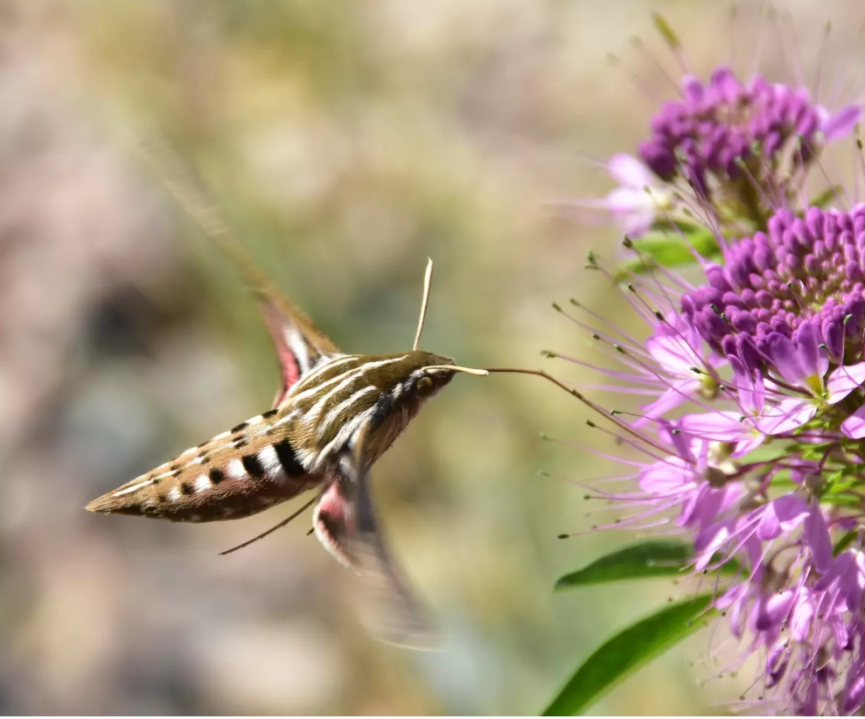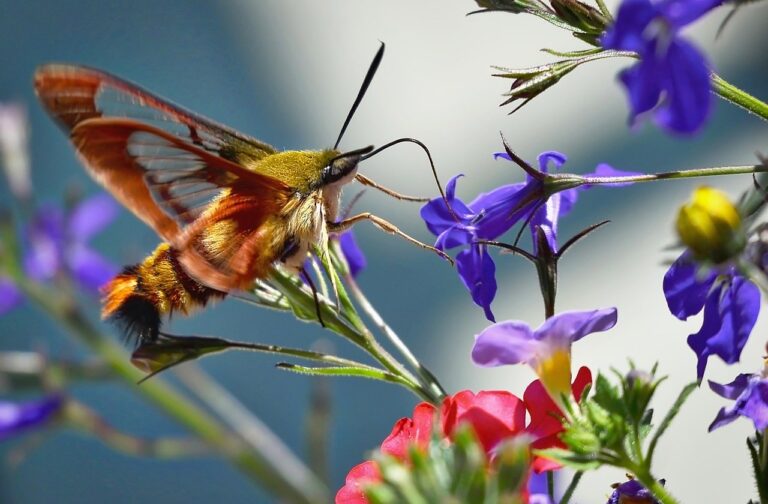Seeing a hummingbird moth is a natural phenomenon where an insect resembling and behaving like a hummingbird visits flowers for nectar. These moths, also known as hawk or sphinx moths, contribute to pollination and are active in warmer months.
Moreover, their mimicry of hummingbirds serves as a defense mechanism against predators. Encountering a hummingbird moth signifies a healthy ecosystem and showcases the diversity of nature.
How do hummingbird moths mimic hummingbirds?
Hummingbird moths, scientifically known as hawk moths or sphinx moths (family Sphingidae), exhibit fascinating behaviors that mimic those of actual hummingbirds.
Furthermore, these behaviors are a result of convergent evolution, where two unrelated species develop similar traits due to similar ecological niches:
Hovering: One of the most striking behaviors of hummingbird moths is their ability to hover in mid-air while feeding on nectar from flowers, just like hummingbirds. They achieve this by rapidly flapping their wings, sometimes at a rate of 70 to 90 beats per second. This hovering behavior allows them to access nectar from deep-throated flowers that other insects might not reach.
Proboscis: Hummingbird moths have long, tube-like proboscises that they use to extract nectar from flowers. They can extend and retract their proboscises, enabling them to reach deep into the flower’s nectar source. This adaptation is similar to the elongated bills of hummingbirds, designed for efficient nectar extraction.
Feeding on the Wing: Like hummingbirds, hummingbird moths can feed on the wing, maintaining their position in front of a flower while they extract nectar.
In addition, this is a high-energy activity that requires excellent coordination and control, making it a remarkable feature of their behavior.
Comparison with Actual Hummingbirds

While hummingbird moths closely resemble hummingbirds in their behavior and appearance, there are key differences to distinguish between them:
Taxonomy: Hummingbird moths are insects belonging to the order Lepidoptera, while hummingbirds are birds from the order Apodiformes.
Moreover, they are unrelated species that have converged upon similar traits due to their ecological roles.
Body Structure: Hummingbirds have feathers, beaks, and a completely different internal anatomy from hummingbird moths. Moths have six legs, a segmented body, and wings covered with scales, like other insects.
Feeding Mechanism: While both species feed on nectar, hummingbirds use their bills, which can vary in shape and size among species, whereas hummingbird moths use their proboscises, which are more elongated and flexible.
Habitat: Hummingbirds are primarily found in the Americas, whereas hummingbird moths are distributed more globally, with various species inhabiting different regions.
Why do hummingbird moths mimic hummingbirds?
The evolution of mimicry in hummingbird moths is a fascinating example of how species adapt to their environments and ecological niches. This mimicry has likely developed over millions of years and is driven by several key factors:
Ecological Niche: Both hummingbirds and hummingbird moths occupy a similar ecological niche as nectar-feeding pollinators. They both rely on flowers as their primary source of food. This shared ecological niche has driven the convergence of their behaviors and appearances.
Evolutionary Pressure: Evolutionary pressure in the form of natural selection plays a crucial role in shaping the traits of species. In the case of hummingbird moths, individuals that closely resembled hummingbirds may have had a survival advantage.
Furthermore, this advantage could include improved access to nectar, reduced predation, and increased reproductive success.
Selection for Efficiency: Natural selection favors traits that improve an organism’s efficiency in its environment. The hovering and nectar-feeding behaviors seen in both hummingbirds and hummingbird moths are highly efficient for obtaining energy-rich nectar. The evolution of these traits enhances the survival and reproductive prospects of these organisms.
Purpose of Mimicry in Deterring Predators
The mimicry of hummingbirds by hummingbird moths serves several important purposes in deterring predators:
Predator Avoidance: Predators often avoid potential prey that exhibit unfamiliar or unusual behaviors or appearances. The rapid and precise hovering, along with the physical resemblance to hummingbirds, can confuse and deter predators that are not accustomed to capturing such prey.
Reduced Vulnerability: Hummingbirds are known for their agility and evasive flight maneuvers, making them difficult prey for many predators. By mimicking these characteristics, hummingbird moths reduce their vulnerability to predation.
Protection during Feeding: While feeding on nectar, both hummingbirds and hummingbird moths are relatively immobile and focused on their food source. This can make them vulnerable to ambush predators.
In addition, the mimicry of hovering hummingbirds may create the illusion of a less vulnerable target, discouraging predators from approaching.
Increased Survival and Reproduction: Individuals of hummingbird moths that successfully deter predators have a better chance of surviving to reproductive age and passing on their genes. Over time, this can lead to the prevalence of mimicry traits in the population.
How do hummingbird moths pollinate?
Hummingbird moths play a significant role in pollination within their ecosystems, and their behaviors are finely tuned for this purpose:
Nectar-Feeding: The primary role of hummingbird moths in pollination is their visitation to flowers for nectar. As they feed on nectar, they come into contact with the reproductive structures of the flowers, including the stamen (male) and pistil (female). This contact facilitates the transfer of pollen from one flower to another.
Long Proboscis: Hummingbird moths possess long, slender proboscises, which allow them to reach the nectar deep within the flower’s throat. This adaptation ensures that they can access nectar from a wide variety of flowers, including those with long floral tubes that other pollinators might not reach.
Pollen Transfer: When a hummingbird moth feeds on a flower, its body inadvertently collects pollen.
However, this pollen is then transferred to the next flower it visits, effectively cross-pollinating different plants. Cross-pollination is essential for the genetic diversity and health of plant populations.
Specialization: Some species of hummingbird moths have specialized relationships with specific types of flowers. For example, the white-lined sphinx moth (Hyles lineata) is known to pollinate certain species of evening primroses (Oenothera spp.) exclusively. Such specialization enhances the efficiency of pollination for both the moth and the plant.
Importance of Their Presence in Ecosystems:=
The presence of hummingbird moths in ecosystems carries several ecological and environmental benefits:
Biodiversity: Hummingbird moths contribute to the biodiversity of an ecosystem by pollinating a wide range of plant species. This, in turn, supports diverse populations of plants, including both wildflowers and crops.
Plant Reproduction: Many plants rely on animal pollinators, like hummingbird moths, for successful reproduction. The pollination services provided by these moths help plants produce seeds and fruits, which are crucial for their propagation and the survival of plant species.
Food Web: Hummingbird moths are part of the food web in ecosystems. They serve as a food source for various predators, including birds, bats, and other insects. Their presence helps sustain these predator populations.
Agricultural Benefits: In agricultural settings, hummingbird moths contribute to the pollination of certain crops, such as tomatoes, peppers, and potatoes. This pollination enhances crop yields and supports agricultural productivity.
Conservation: The conservation of hummingbird moths and their habitats is important not only for their intrinsic value but also for the preservation of the broader ecosystem. Protecting these moths helps ensure the health and sustainability of native plant communities.
How do hummingbird moths time their activity with flowers?

Hummingbird moths exhibit specific activity patterns that are influenced by various environmental factors, including temperature, daylight, and the availability of nectar-producing flowers:
Diurnal Behavior: Most hummingbird moth species are diurnal, meaning they are active during daylight hours. This aligns with the blooming patterns of many flowers, which also open during the day to attract pollinators.
Temperature Sensitivity: Hummingbird moths are ectothermic, which means their activity levels are highly dependent on temperature. They are typically most active when temperatures are warmer, as their flight muscles require adequate warmth to function optimally.
Feeding Periods: Hummingbird moths have feeding periods interspersed with rest intervals. During their active phases, they search for nectar-rich flowers and hover while feeding. Between feeding bouts, they may rest or seek shelter to conserve energy.
Relationship Between Their Activity and Flower Bloom
The activity patterns of hummingbird moths are closely tied to the blooming schedules of the flowers they pollinate. There is a symbiotic relationship between these moths and the plants they visit:
Synchronization with Flower Bloom: Hummingbird moths are adapted to coincide with the flowering periods of their preferred nectar sources. As flowers bloom and release nectar, hummingbird moths become more active to take advantage of the available food supply.
Nectar Availability: The availability of nectar from flowers directly affects the activity and foraging behavior of hummingbird moths.
Moreover, they are highly responsive to the presence of nectar-producing flowers, and their flight patterns may shift in response to changing nectar sources.
Seasonal Variation: In temperate regions, hummingbird moths are more abundant during the spring and summer months when many flowers are in bloom. As the seasons change and fewer flowers are available, their activity levels may decrease, and they might enter diapause (a period of dormancy) or migrate to more favorable regions.
Migration: Some hummingbird moth species exhibit migratory behavior to follow the seasonal availability of nectar-producing plants.
In addition, they may travel long distances to reach regions where flowers are abundant, contributing to the pollination of plants along their migration route.
Influence on Plant Reproduction: The close alignment of hummingbird moth activity with flower bloom ensures effective pollination. Plants benefit from this synchronization as it enhances their chances of successful reproduction through cross-pollination, resulting in higher seed production and genetic diversity.
FAQ’s
What is the meaning of hummingbird moth in English?
In English, “hummingbird moth” refers to a type of moth that closely resembles and behaves like a hummingbird.
What do different moths symbolize?
The symbolism of moths can vary across cultures and beliefs. Generally, they are associated with transformation, intuition, and vulnerability.
What is a moth that looks like a leaf?
A moth that looks like a leaf is often called a “leaf moth” or “leaf mimic moth.” These moths have evolved to resemble leaves as a form of camouflage.
What does a moth look like?
Moths can have diverse appearances, but they typically have a winged insect body with antennae, and many species have patterns or colors that help them blend into their surroundings.
What do moths symbolize in Islam?
In Islam, moths are generally seen as symbols of the transitory nature of life and the pursuit of spiritual enlightenment. They are mentioned in some Islamic poetry and literature.
Are moths lucky?
The perception of moths as lucky or unlucky can vary greatly depending on cultural beliefs. Some cultures consider moths to bring luck, while others associate them with omens or negative connotations.
Final Thought
In conclusion, when you see a hummingbird moth, you’re witnessing a remarkable natural phenomenon. These moths have evolved to act and look like hummingbirds, which helps protect them from predators.
Additionally, they play a crucial role in pollination, helping plants reproduce.
Moreover, their activity is closely connected to the blooming of flowers, ensuring they have enough nectar to feed on. So, if you ever spot a hummingbird moth, remember that it’s not just a curious sight; it’s also a vital part of our ecosystem.

